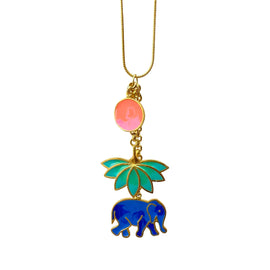In a world where art is ever changing, enamel painting has been a go-to in the artist’s world. Since the 6th century, cultures across the continents have utilized this medium in paintings, pottery, and more importantly: jewelry. Why? Enamel is colorful, versatile, and worn in everyday life of fashion. From sprucing up an outfit, to making a statement, enamel painting has been a crutch for a designer’s work. Throughout this article, you will learn everything you need to know about your enamel jewelry, from the different techniques to the care and maintenance.

What is Enamel Jewelry:
Enamel is a coating made by applying a colored powdered glass to the base metal at very high temperatures. It has been used since ancient times, with vases, bowls, and jewelry. Creating pieces with enamel requires great skill and a knowledge of the different techniques an artist can use in their pieces.

The Different Enameling Techniques:
As mentioned, there are many techniques in utilizing enamel painting. The most common types artists use are the cloisonné, the grisaille, the champlevé, the limoges, and the plique-a-jour.
- Cloisonné: This is one of the earliest techniques, utilizing wires as a part of the piece. The artist fills a small wire enclosure with wet enamel powders, and then fires.
- Grisaille: This method is mainly used to achieve the effect of light and shade on jewelry, by applying white enamel to a black enamel background, creating shading and halftones.
- Champlevé: This type of enamel painting lets the base metal remain exposed. The artist hammers, stamps or carves into the metal to form depressions where the enamel can then be applied. After it is fired, the enamel fills out the impressions, creating a smooth surface between the base metal and the enamel.
- Limoges: As the most common type of enamel painting, this technique allows the enamel to touch each other without having to separate it with wires.
- Plique-à-jour: This technique is used without any type of metal backing, where the enamel is painted into cells, made of gold or silver wire, and allows light to shine through the enamel.

The Distinct Process of Creating Enamel Jewelry:
- Preparation: The first step will always be to clean and prepare the metal surface, to ensure proper adhesion of the enamel. Often, artists will use copper, fine silver, or high karat gold as their base metal.
- Applying the Enamel: The powdered enamel, which is available in multiple colors, is carefully applied to the metal. This can be achieved through different techniques, such as dusting, sifting, or wet application.
- Firing: The jewelry piece is then fired in a kiln, usually between 750 to 900 degrees Celsius (1380 to 1650 degrees Fahrenheit). This process melts the powdered enamel, allowing it to flow and adhere to the metal.
- Cooling and Repeating: Once the jewelry has been fired, the piece needs to cool. Depending on the desired design, multiple layers of enamel and firing may be repeated to achieve the desired thickness and color intensity.
- Finishing: After the final firing and once the enamel jewelry has cooled completely, then the piece needs to be polished to enhance its shine and smoothness. Additional embellishments or setting may be added at this final stage, such as gemstones or metal accents.
Caring for Your Enamel Jewelry:
- Proper Cleaning: Do not clean enamel jewelry with harsh household chemicals, this will damage the piece. Instead, use lukewarm water, a soft cloth, and hand soap.
- Avoid Accident-Prone Locations: Keep this type of jewelry safe from falling, since enamel will crack on impact.
- Place Gently: Do not chuck enamel jewelry into a ring or bracelet dish since this will cause abrasions or chipping. Instead, have it lay flat in a cloth or felt lined jewelry box.
See finished pieces by the designer Uchita Shah at the link: https://www.designsbyuchita.com/collections/enamel-collection



